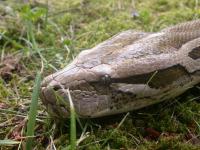
Burmese python. Burmese pythons don’t eat very often, but when they do they like to pig out, ingesting the whole of their prey. There’s very little waste as they are able to digest everything, apart from hair and feathers. Dr Jean-Hervé Lignot (Louis Pasteur University) and Dr Robert K. Pope (Indiana University South Bend) will talk about the implications this has on the way these snakes digest food on Saturday 31st March at the Society for Experimental Biology’s Annual Meeting in Glasgow.
"Juvenile pythons normally eat every week, while adults can have a meal every month and can even stop feeding for several months under certain circumstances," explains Dr Lignot. "They are therefore physiologically fine tuned to cope with prolonged fasting, re-feeding on large meals, and intense digestion and nutrient absorption".
Researchers monitored changes in the python gut after feeding. They observed drastic morphological changes, which coincided with a rapid increase in body temperature. Cell replication and death were sparked soon after feeding, as new cells were produced and worn out cells eliminated. In this way the stomach and intestine re-modelled themselves in anticipation of the next fasting and feeding periods.
An exciting development was the discovery of a new cell type in the small intestine of pythons which is responsible for the degradation of bone. Small particles observed in the intestine and colon of pythons within hours of feeding were found to have originated from the prey’s skeleton. These particles are degraded in specialised cells, shaped like golf tees, and the components released into the bloodstream. This process is thought to allow pythons to optimise absorption of calcium (a component of bone) from their meals. Source : Society for Experimental Biology
 Print Article
Print Article Mail to a Friend
Mail to a Friend
